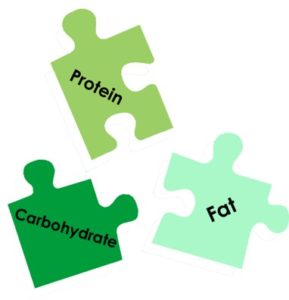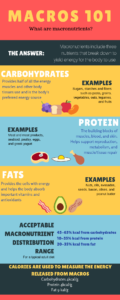
Coming up with a healthy meal can sometimes be overwhelming. From portion sizes, to choosing the best protein option, there are a lot of things that factor into making a healthy and balanced meal. To start off, it’s important to understand what macronutrients are. Everything you eat can be categorized into 3 different macronutrients: protein, carbohydrates, or fats.

Macronutrients are broken down to yield energy for the body to function, and your body requires them in large amounts. They also contribute the materials needed for building the body’s tissues. Let’s dive into the macronutrients to make sure you understand the role each plays within the body.
CARBOHYDRATES
Carbohydrates provide the body with half of all the energy muscles and body tissues use throughout the day and are the body’s preferred energy source. Carbohydrates provide glucose which is converted into energy for normal daily activity and physical activity.
The quality of the carbohydrate can make a big difference in your meal:
Low quality examples include
- white bread
- sugar
- sodas
- pastries/cookies
- highly processed and refined foods
High quality examples include:
- unprocessed/minimally processed whole grains
- vegetables
- fruits
- oats
- legumes/beans
High quality carbohydrates provide the body with fiber and many different vitamins and minerals.
PROTEIN
Protein is needed for the body to grow and to repair and replace tissues. It is the building blocks of muscles, blood, and skin. Protein also helps support reproduction and metabolism.
Examples of protein include
- meat and meat products
- seafood
- poultry
- eggs
- Greek yogurt
- cheese
- beans/legumes
- seeds and nuts
The National Academy of Medicine recommends that adults get a minimum of 0.8g of protein per kg of body weight each day
FATS
Fats are essential to the body’s overall health and they provide the cells with energy. They also help the body absorb important vitamins and antioxidants.
Good sources of fats include
- nuts
- oils
- avocados
- seeds
- bacon
- olives
- peanut butter
- other nut butters
It’s important to note “low-fat” items are not always a healthier choice. Many low-fat foods reduce the fat content by replacing it with carbohydrates from sugar, refined grains, or other starches. Our bodies than digest these very quickly and they do not make you feel satiated as long.
If you’re interested in a more scientific explanation of macronutrients, then this video is a great place to start.
PORTION SIZE
Now that you are familiar with what macronutrients are, let’s discuss the appropriate amount your body needs.
The acceptable macronutrient distribution ranges are the ranges of macronutrients that will provide your body with adequate energy. Let’s break it down: Your overall diet should consist of
- 45-65% carbohydrates
- 20-35% fats
- 10-35% protein
One thing that should be pointed out is a person’s diet will vary greatly depending on the individual. There is not “one size fits all” diet or meal plan. You should listen to your hunger cues and eat what works for YOUR body.
Here is an infographic if you’re looking for a quick handout that summarizes everything above:

MY PLATE
Another great resource to use to help understand how you should balance your plate and portions is the MyPlate picture.

This picture is a great visual to help you start your meal planning. I typically will start with a protein and build my plate around whatever protein I choose.
Visit the MyPlate website here to explore even more information!
Key Words: Macronutrients, healthy balance, MyPlate, portion size, meal planning
References:
AdamExplains (March 2018). What are Macronutrients? [VideoFile]. Retrieved from: https://www.youtube.com/watch?v=smPR215SRzM
United States Department of Agriculture. (n.d.) Choose My Plate. Retrieved from: https://www.choosemyplate.gov/
Harvard School of Public Health (n.d.). What Should I Eat? Retrieved from: https://www.hsph.harvard.edu/nutritionsource/what-should-you-eat/
Whitney, E., & Rolfes, S. R. (2018). Understanding Nutrition (15th ed.). Stamford, CT: Cengage Learning.